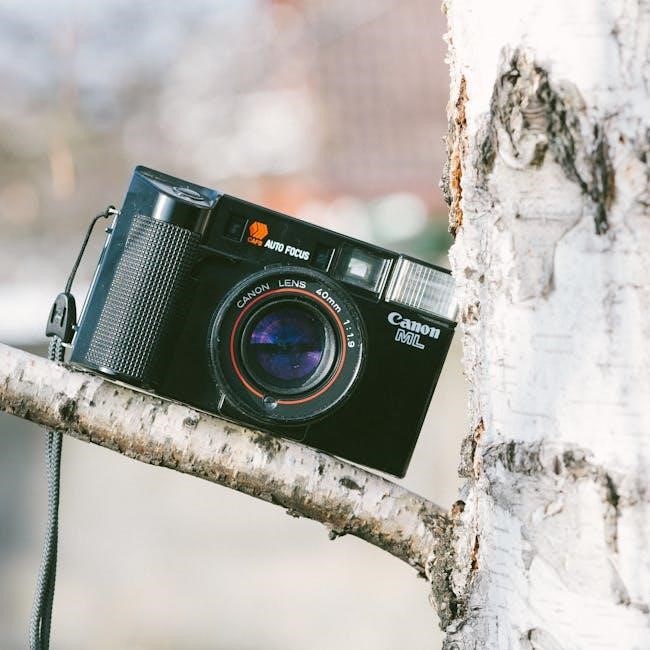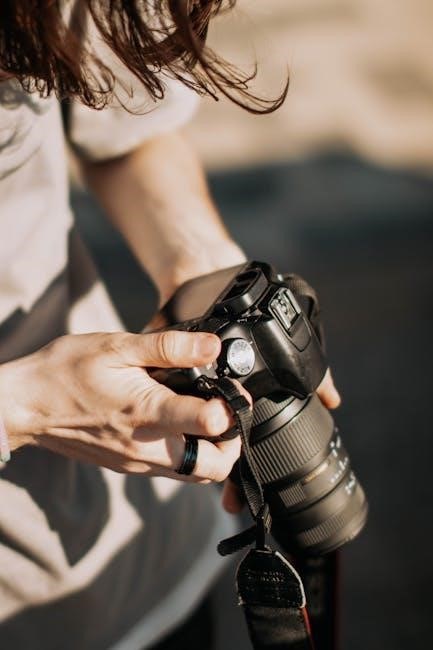
canon 80d instruction manual
The Canon EOS 80D is a versatile DSLR camera designed for both photography and videography, featuring an APS-C sensor, weather-sealed body, Wi-Fi, GPS, and 1080p/60fps video recording.
Overview of the Camera’s Features
The Canon EOS 80D is a high-performance DSLR camera equipped with a 24.2MP APS-C CMOS sensor, offering excellent image quality and versatility. It features a weather-sealed body, making it durable for outdoor use. The camera supports 1080p video recording at 60 fps, along with stereo sound, ideal for videographers. It includes built-in Wi-Fi and GPS for easy file transfer and geotagging. The EOS 80D also boasts a 45-point all-cross-type AF system for precise focusing and a 7 fps burst mode for capturing fast-moving subjects. A vari-angle touchscreen LCD enhances composition and navigation. With Dual Pixel AF for smooth autofocus in live view and video, custom shooting profiles, and adjustable ISO settings, the EOS 80D is a powerful tool for both enthusiasts and professionals.
Importance of Using the Instruction Manual
The instruction manual is essential for unlocking the full potential of the Canon EOS 80D. It provides detailed explanations of camera functions, shooting modes, and customization options, ensuring users understand how to optimize settings for their needs. The manual also includes troubleshooting guides to resolve common issues, helping photographers avoid costly repairs. By familiarizing oneself with the manual, users can master advanced techniques, such as adjusting ISO, white balance, and utilizing custom profiles. Additionally, the manual offers insights into video recording capabilities, including 1080p at 60 fps and stereo sound. Whether for beginners or professionals, the manual serves as a comprehensive resource to enhance creativity and technical proficiency with the EOS 80D.
Getting Started with the Canon EOS 80D
Unbox and charge the battery, then mount the lens. Insert a memory card and power on the camera. Familiarize yourself with the controls and menu system to customize settings for your first shoot.
Unboxing and Initial Setup
When unboxing the Canon EOS 80D, carefully remove the camera, lens, battery, charger, and accessories. Install the battery, charge it fully, and insert it into the camera. Mount the provided lens or your preferred one, ensuring it clicks securely. Insert a compatible memory card into the slot, preferably a Class 10 or higher SD card for optimal performance. Power on the camera and navigate to the menu to set the language, date, time, and other initial preferences. Familiarize yourself with the camera’s layout, including the mode dial, buttons, and LCD screen. This setup ensures you’re ready for your first shoot.
Basic Camera Controls and Layout
The Canon EOS 80D features an intuitive design with well-placed controls for easy access. The mode dial on top allows quick switching between shooting modes, while the shutter button is conveniently located on the top right. Adjacent to it are buttons for ISO and AF, enabling rapid adjustments. On the rear, the 3-inch LCD screen displays settings and images, with the Quick Control Dial and Multi-controller simplifying menu navigation. Key buttons like White Balance and Playback are within easy reach, ensuring seamless operation. The camera’s ergonomic grip and logical layout make it user-friendly for photographers of all skill levels. Understanding these controls is essential for mastering the camera’s functionality and enhancing your photography experience.

Shooting Modes and Settings
The Canon EOS 80D offers versatile shooting modes, including Manual, Auto, and semi-auto options, allowing users to balance creative control with convenience for optimal photography.
Understanding Manual Shooting Mode
Manual mode on the Canon EOS 80D grants full control over aperture, shutter speed, and ISO, enabling precise adjustments to capture desired effects. By adjusting these settings, photographers can achieve shallow depth of field, freeze or blur motion, and manage exposure for creative results. The camera’s built-in light meter provides guidance, but users have the freedom to override it for artistic purposes. This mode is ideal for experienced photographers or those seeking to enhance their technical skills, as it allows for complete customization of each shot. Mastering manual mode unlocks the full potential of the EOS 80D’s capabilities.
Auto and Semi-Auto Shooting Modes
The Canon EOS 80D offers multiple auto and semi-auto shooting modes, catering to users who prefer convenience while still maintaining some control. Scene Intelligent Auto mode automatically adjusts settings for optimal results in various scenarios. Creative Auto mode allows basic adjustments, such as background blur and brightness, while the camera handles the rest. Semi-auto modes, like Aperture Priority (Av), Shutter Priority (Tv), and Program Auto (P), provide more creative freedom, letting users control specific settings while the camera manages others. These modes are ideal for photographers who want to balance ease of use with artistic expression, making them versatile for everyday shooting and diverse photography scenarios.

Video Recording with the Canon EOS 80D

The Canon EOS 80D excels in video recording, offering 1080p resolution at 60 fps with stereo sound. Manual controls enable precise adjustments for professional-grade video capture and editing flexibility.
Setting Up for Video Recording
Setting up your Canon EOS 80D for video recording involves selecting the appropriate mode and adjusting key settings. Begin by switching to Movie mode using the top dial. Choose 1080p at 60 fps for smooth motion. Enable manual focus or use Movie Servo AF for tracking subjects. Adjust exposure compensation and ISO for optimal lighting. Monitor audio levels and consider using an external microphone for better sound quality. Use the touchscreen to select focus points or enable face tracking. Stabilization settings can enhance handheld shooting. Ensure your memory card is compatible with video recording demands. Refer to the instruction manual for detailed guidance on customizing settings for professional-grade video capture.
Recording in 1080p at 60 FPS
Recording in 1080p at 60 FPS with the Canon EOS 80D delivers smooth and detailed video, ideal for capturing dynamic scenes. To enable this setting, navigate to the Movie Recording Size menu and select 1080p at 60 fps. Ensure your memory card supports high-speed writing for uninterrupted recording. For optimal results, use manual focus or Movie Servo AF to maintain sharpness. Adjust exposure settings and ISO to suit lighting conditions. Enable external microphones for enhanced audio quality. Utilize the camera’s stabilization features to reduce camera shake. Refer to the instruction manual for additional customization options to enhance your video production. This setting is perfect for sports, action, and high-motion content, ensuring professional-grade output.

Customizing Your Camera
Customize your Canon EOS 80D by adjusting ISO, white balance, and creating custom shooting profiles to suit your photography style and capture unique shots effortlessly.
Adjusting ISO and White Balance
Adjusting ISO and white balance on the Canon EOS 80D allows for precise control over image quality and color accuracy. The ISO setting determines the camera’s sensitivity to light, with lower values (ISO 100-400) suitable for bright conditions and higher values (ISO 6400-16000) for low-light situations. However, higher ISOs may introduce noise. White balance ensures accurate color representation by matching the lighting conditions of the scene. Common presets include Auto, Daylight, Shade, Tungsten, and Fluorescent. Custom white balance enables precise calibration using a reference object. Properly adjusting these settings enhances image quality and creative control, making them essential tools for photographers aiming to capture stunning visuals with the EOS 80D.
Using Custom Shooting Profiles
Custom shooting profiles on the Canon EOS 80D allow photographers to save personalized settings for quick access, enhancing workflow efficiency. These profiles store parameters such as ISO, white balance, autofocus modes, and metering options. Users can create multiple profiles tailored to different shooting scenarios, like portraits or landscapes. Accessing these profiles is straightforward through the camera’s menu, ensuring seamless transitions between setups. Additionally, custom profiles can be linked to specific camera modes, providing an intuitive way to adapt to varying conditions. This feature is particularly useful for professionals and enthusiasts who need consistent results without repeatedly adjusting settings, thereby streamlining their creative process and improving productivity.
Connectivity and Sharing
The Canon EOS 80D features built-in Wi-Fi and GPS, enabling seamless photo transfers to mobile devices and geotagging. Compatible with Android and iOS, it supports remote control via the Canon Camera Connect app, making sharing and management effortless.
Wi-Fi and GPS Functionality

The Canon EOS 80D incorporates built-in Wi-Fi and GPS capabilities, enhancing connectivity and location-based photography. Wi-Fi allows for wireless image transfers to smartphones, tablets, and computers, as well as remote camera control via the Canon Camera Connect app. The GPS feature enables geotagging, embedding location data into images for easier organization and sharing. These features are particularly useful for travel photography and vlogging, ensuring seamless integration with mobile devices and online platforms. The Wi-Fi function supports Android versions 4.0-4.4/5.0-5.1 and iOS versions 7.1/8.3, making it compatible with a wide range of devices. This connectivity simplifies sharing and manages workflows efficiently.
Transferring Photos to Mobile Devices
Transferring photos from the Canon EOS 80D to mobile devices is streamlined via built-in Wi-Fi and the Canon Camera Connect app. Enable Wi-Fi on the camera, launch the app on your smartphone or tablet, and follow on-screen instructions to establish a connection. Once linked, you can transfer images, review them on a larger screen, or share them instantly on social media. The app also allows remote shooting, enhancing creative control. This feature is particularly useful for vloggers and photographers needing quick access to their content. Ensure your device runs compatible Android (4.0-5.1) or iOS (7.1-8.3) versions for seamless functionality.

Maintenance and Troubleshooting
Regularly clean the sensor and lens to maintain image quality. Update firmware for new features and bug fixes. Troubleshoot common issues using Canon’s online support resources.
Cleaning and Updating Firmware
Regular cleaning of the Canon EOS 80D’s sensor and lens is essential for maintaining image quality. Use a soft brush or blower to remove dust, and dampened swabs for stubborn spots. For firmware updates, visit the Canon website, download the latest version, and follow on-screen instructions. Ensure the camera is fully charged or connected to a power source during updates to prevent interruptions. Updating firmware enhances performance, adds new features, and fixes bugs. Always refer to the manual for detailed cleaning and update procedures to ensure optimal camera functionality and longevity.
Resolving Common Issues
Common issues with the Canon EOS 80D include error messages, autofocus malfunctions, and connectivity problems. Refer to the instruction manual for troubleshooting steps, such as resetting the camera or updating firmware. For error messages, check the manual’s troubleshooting section. Autofocus issues may require calibrating lenses or cleaning the sensor. Connectivity problems can often be resolved by restarting the camera or updating Wi-Fi settings. Visit Canon’s support website for additional resources and software updates. Regular maintenance, like cleaning and updating firmware, helps prevent issues and ensures optimal performance. Always consult the manual or Canon’s official support for detailed solutions.